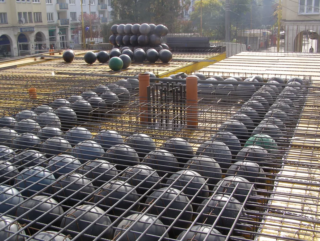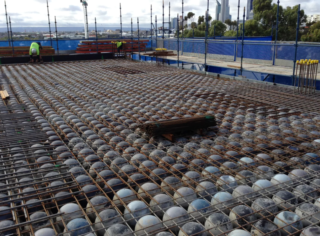A technology that provides for the creation of a biaxial hollow slab, where hollow balls are included in the element. Due to these balls, the weight of the structure is significantly lower, and the bearing properties remain at the required level.
BubbleDeck literally means bubble deck. That is, this is an ordinary monolithic slab that has all the properties of a concrete fellow, with the exception of the absence of a weighting middle, which is evenly filled with BubbleDack balls.
When creating a slab using the BubbleDeck technology, the geometric features of the combination of the shape of the ball and the cell of the reinforcing base are taken into account. That is, the entire concrete element is a calculated and tested scheme for an effective combination of reinforcement, concrete and plastic balls, hollow inside.
What the technology is based on and its features
Plates made using BubbleDack technology have the following characteristics:
- honeycomb structure provides increased strength;
- reducing the load on the base / foundation by reducing the mass;
- evenly distributed cavities over the entire area of the monolith, which is filled with air in an additional, durable shell;
- increased sound and heat insulation due to the air cushion.
The basis of the unique BubbleDeck system - balls
Such characteristics open up opportunities for the creation of structures with a large area in short periods of time. These buildings include: trade pavilions; exhibition centers; indoor sports grounds and other overall objects.
There are no normative documents that regulate size restrictions and their ratio. At the same time, at this stage, production of the maximum possible size is limited to 16 meters in length and 2.4 meters in width.
The method of production and technological features allow you to create geometric shapes of the slabs according to the customer's sketch.
Despite a number of advantages and technical capabilities, this method of pouring interfloor floors, which is based on a modular system using hollow balls, affects the formation of the estimated cost, reducing it. And this is not the only advantage of the new construction technology.
Pros and cons of hollow panels
The budget savings are made up of a number of factors. The use of BubbleDeck is characterized by cost savings based on the following parameters:
- reduction of concrete consumption by more than 30% due to cavities formed by balls;
- reduction in the number of steel reinforcing elements by more than 20%, with increased strength characteristics due to the unique technology of manufacturing the module;
- reduction of labor costs for lifting equipment when lifting these plates, it is possible to provide a lift of about 200m2 per hour, or in terms of plates - 10 pieces of approximately 20m2 each;
- BubbleDeck panels require fewer construction professionals to assemble and fill in less time.
The main disadvantages of BubbleDeck include the use of non-original technology in the formation of panels (void formers of various shapes and materials), due to which the characteristics are violated. Insufficiently implemented system in multi-storey construction in Russia. In terms of efficiency and economy, no significant disadvantages were found.










